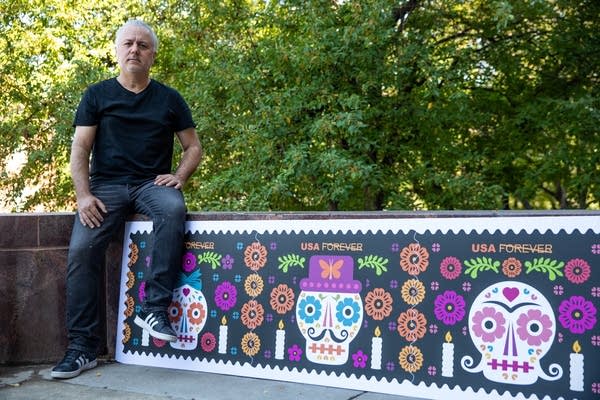Minneapolis artist's Día de los Muertos designs break new ground as Postal Service stamps

Go Deeper.
Create an account or log in to save stories.
Like this?
Thanks for liking this story! We have added it to a list of your favorite stories.
Día de los Muertos has figured in Luis Fitch’s art for the past 25 years — at about the same time he moved to Minneapolis. Now his Day of the Dead art has merged with his lifelong dream of creating a postage stamp.
Fitch’s design of a Day of the Dead U.S. postage stamp makes a nationwide debut Thursday during a first day of issue ceremony in El Paso, Texas. It’s the first U.S. stamp to feature Día de los Muertos.
Fitch remembered receiving the call with the offer to design the stamp.
“I said a bad word inside my head. Because I thought he was joking, that it was a friend of mine that knew that I wanted to design a stamp,” Fitch said. “He told me enough information that I knew he was real, obviously. And so I got very excited.”
Turn Up Your Support
MPR News helps you turn down the noise and build shared understanding. Turn up your support for this public resource and keep trusted journalism accessible to all.
Antonio Alcala, one of four contracted art directors for the Postal Service came across Fitch’s work while visiting Chicago several years ago. It was part of an exhibit on ofrendas and Day of the Dead at the National Museum of Mexican Art.
“When the assignment came to do a Day of the Dead stamp, I thought of his work immediately, because it was just very graphic and colorful and bold and smart. And I thought it would be perfect for what the Postal Service needed,” Alcala said.
Día de los Muertos is Nov. 1 and Nov. 2 in Mexico. It is also celebrated in other parts of Latin America — although they may differ slightly. It’s when the souls of loved ones who have died return for 24 hours to be with the living. Ofrendas — offerings in the form of altars — are created and include the loved ones’ favorite foods and drink, as well as cempasuchil (Mexican marigolds), candles and calaveras.

Fitch is one of the founders of Uno Branding. His fascination with stamps goes back to when he was growing up in Tijuana. He joined a stamp collector’s club in junior high school.
“I was the youngest, I was probably 12 years old. And everybody else was adults. Every Saturday they got together and exchanged stamps, and talked about the stamps. That was my first exposure to stamps,” Fitch said.
His neighbors knew he collected stamps and saved postcards and letters for Fitch. He carefully removed the stamps and returned the mail.
“There is so much graphic design in each of the stamps. And there’s always historical information that you can learn from it,” he said.
His family would eventually move to San Diego. He lived very close to the main post office. He’d go there a lot, he said, because it was next to the public library.
When he was 18, Fitch asked a postal clerk about designing a stamp.
“He actually had a brochure,” Fitch said.
“A month later I got a letter. And basically, they were saying that my style was not appropriate for what they were looking for.”
He forgot about it until three years ago when he presented at the American Institute of Graphic Arts. One of the other presenters was a designer from New York. She talked about a stamp she made.
“Everything came back to me. It’s like ‘oh my God, I got to design a stamp,’ ” Fitch said.
In October 2019, Fitch put at the top of his birthday goals list that he would design a stamp. A day later, on his birthday, he got a call from Alcala, the postal services creative director, asking if he wanted to design a Día de los Muertos stamp.
He recalled Alcala telling him not to get too excited because it can take between three to six years to go through the whole process.
“It’s very exciting for me to see the United States embrace that aspect, some of our culture,” Alcala said.
Fitch submitted four designs of calaveras, or skulls, representing a mom, dad, girl and boy. The stamps also have marigolds and candles in bright colors.
“It’s the whole family. I think family is one of the biggest things that distinguish Latinos as a community,” Fitch said.
Vicki Adame covers Minnesota’s Latino communities for MPR News via Report for America, a national service program that places journalists into local newsrooms to report on undercovered issues and communities.




